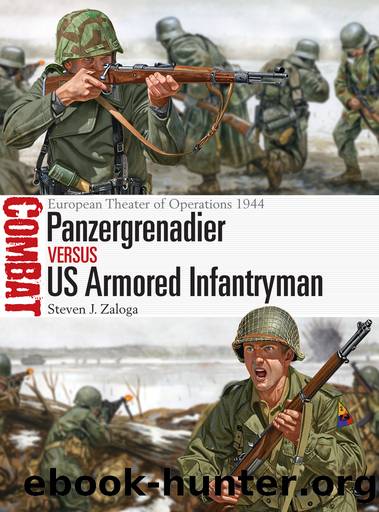Panzergrenadier vs US Armored Infantryman by Steven J. Zaloga

Author:Steven J. Zaloga
Language: eng
Format: epub
ISBN: 9781472817099
Publisher: Bloomsbury Publishing
Published: 2016-06-15T00:00:00+00:00
Here, an M1 57mm antitank gun of the 41st Armored Infantry Regiment is set up on the streets of Pont-Brocard, center of the German Red Line defenses. An M4 medium tank passes by in the background. In the background is an abandoned SdKfz 251/3 armored radio half-track of the Panzer-Lehr-Division.
The first roadblock was encountered at Quibou, part of the Panzer-Lehr-Division’s Yellow Line defenses. This had served as a collection point for German troops withdrawing the previous evening. The town was defended by two Panther tanks and an assortment of Panzer-Lehr-Division troops. After overcoming this force, the American columns continued through Dangy. The town was defended by a Panzergrenadier company and a 7.5cm antitank gun that was overcome with tank fire and dismounted infantry.
The next major town on the road, Pont-Brocard, was part of the third Red Line defenses on the Soulles River and was defended by a Kampfgruppe consisting of two understrength companies of Panzergrenadier-Lehr-Regiment 901 and the remaining troops of Panzer-Lehr-Pionier-Bataillon 130 along with a few antitank guns and 8.8cm Flak guns. This defense line was overrun around 1630hrs. Bayerlein and the divisional command post were located near of the edge of the woods east of Pont-Brocard using a bus as a mobile command post. The main headquarters was bypassed by M5A1 light tanks and the staff fled to a neighboring apple orchard where the HQ radio section was located. In exasperation, Bayerlein sent out a bitter radio message to corps headquarters: “After 49 days of fierce combat, the Panzer-Lehr-Division is finally annihilated. The enemy is now rolling through all sectors, from St. Gilles to the south. All calls for help have gone unanswered because no one believes the seriousness of the situation.”
The fighting on July 25–27 had reduced the Panzer-Lehr-Division to a torso division with few combat-effective troops. Much of its core administrative and service elements survived the battle even though its Panzergrenadier and Panzer troops did not. It was this combat-ineffective “torso” that retreated and was later used to reconstruct the division for further actions along the German frontier in September 1944. Operation Cobra had successfully pushed aside the main German defense line, permitting a First US Army break-out from Normandy toward Paris. The 2nd Armored Division would cross the French frontier into Belgium four weeks later.
Download
This site does not store any files on its server. We only index and link to content provided by other sites. Please contact the content providers to delete copyright contents if any and email us, we'll remove relevant links or contents immediately.
| Africa | Americas |
| Arctic & Antarctica | Asia |
| Australia & Oceania | Europe |
| Middle East | Russia |
| United States | World |
| Ancient Civilizations | Military |
| Historical Study & Educational Resources |
SAS Jungle Survival by Davies Barry(865)
The Complete U.S. Army Survival Guide to Shelter Skills, Tactics, and Techniques by Jay McCullough(717)
The Wind Book for Rifle Shooters by Linda K. Miller(677)
Great Hunting Rifles by Terry Wieland(664)
Art of Gunsmithing by Lewis Potter(651)
The Complete SAS Survival Manual by Barry Davies(608)
U.S. Army Guide to Military Mountaineering by Department Of The Army(588)
The Manhattan Project: The Birth of the Atomic Bomb in the Words of Its Creators, Eyewitnesses, and Historians by Cynthia C. Kelly & Richard Rhodes(582)
Hank Reinhardt's Book of Knives: A Practical and Illustrated Guide to Knife Fighting by Hank Reinhardt(566)
The Gun by C. J. Chivers(563)
U.S. Army Guerrilla Warfare Handbook by Department Of The Army(553)
Glock by Paul M. Barrett(553)
Drone Warfare by Medea Benjamin(534)
The Future of Violence: Robots and Germs, Hackers and DronesConfronting A New Age of Threat by Benjamin Wittes & Gabriella Blum(512)
SAS Ultimate Guide to Combat (General Military) by Stirling Robert(505)
Booby Trap(493)
Drones and Terrorism by Grossman Nicholas;(471)
The Panther Tank by Anthony Tucker-Jones(470)
Churchill's Shadow Raiders by Damien Lewis(464)
